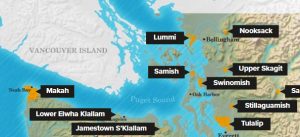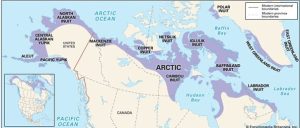Indigenous Cultures of the North
Bob Rein
October 2023
I have always had a fascination for Native American peoples. I have researched various nations that caught my attention because of their way of life, their relationship to the land and nature, the complexity of their tribal structures, and their beliefs in higher powers. As my interest is in exploring the north, I am learning of the depth and breadth of the U.S. and Canadian indigenous societies. From the pacific northwest coastal regions and the western shores of British Columbia on up to Alaska and then over the northern Canadian Provinces of the Yukon, Northwest Territories, Nunavut, and then on to Labrador, these regions were and still are the ancestral homes to hundreds of native populations.
If one was to explore or go on epic adventures, most likely, you would interact or at minimum, need permission or permits to be on their land. Let’s look at the different indigenous groups by area of exploration:
The Inside Passage:
- Starting in the state of Washington, you may encounter 7 tribes whose land borders on the passage. Starting at the west coast, where the Pacific Ocean meets the Straits of Juan de Fuca, are the Makah, Lower Elwha Klallam, and the Jamestown S’Klallam people. Going east and then north through the San Juan Islands are the Tulalip, Swinomish, the Samish, and the Lummi. Other nations shown on the map below are technically not on the passage.

- As you travel north through the passage and cross over to Canada, along the coastline of British Columbia and east of Vancouver Island up towards Haida Gwaii, there are four major nations whose land you will pass through or need to stop at. Even though British Columbia is home to 204 Nations, the major nations along the passage starting on the Sunshine Coast and moving north are the Shishalh, the Tla’amin, the Klahoose, and the Haida found on Haida Gwaii.
- The final major geographical area of the passage is southeastern Alaska. The people that inhabit this part of the passage include the Eyak, the Haida, the Tsimshian, and the Tlingit.
The Northwest Passage, The Arctic, & Alaska (the portion not part of the Inside Passage):
Along the Northwest Passage, you will be passing by or stopping on the land of several Inuit groups: the Baffinland, the Caribou, the Iglulik, the Netsilik, and the Copper.
Essentially, there are three groups of Indigenous peoples that live in the Alaskan areas. They include different Inuit groups, the Yupik, and the Aleut people.
Additionally, there are other nations of the Arctic shown on the map are outside the areas of exploration I’ve called out with the exception of the Mackenzie Inuit nation which borders on both the Yukon and Arctic regions.
The map below shows which groups inhabit which locales.

The Northern Canadian Provinces (The Yukon & The Northwest Territories). Nunavut is included in the Northwest Passage / Arctic discussion.
The Yukon is inhabited by six principal nations: the Gwichʼin, the Hän, the Kaska Dena, the Tagish, the Northern and Southern Tutchone, and the Tlingit (Teslin). The Mackenzie Inuit territory borders on both the Yukon and Arctic as noted above.
There are 27 First Nations that inhabit the Northwest Territories. In terms of larger ethnic groupings, First Nations in the Northwest Territories are primarily Dene, with some Cree. The Northwest Territories also has large Inuvialuit and Métis populations.
Helpful Hints:
If you will be stopping on indigenous land, be sure to:
- Call ahead and inquire about any permits that might be needed for camping.
- Even though you will be in bear country, consider taking bear spray over carrying a firearm. Weapons of any kind may be prohibited on native land.
- Ask for permission before taking any photos of either cultural structures or of the people themselves.
- Always adhere to “Leave No Trace” principles.
Why is this information important? As I explore and have adventures in the north, much of what I have done and plan to do is on the land of these nations. Despite a cruel history of how the US and Canada have treated the indigenous peoples, my experience and the experience of fellow adventurers and explorers has been very positive. Interactions with the various groups have proven extremely helpful and they are eager to have you as a visitor and allow access to their land. By respecting their culture and rules, obtaining the necessary permits, if required, can foster positive relationships, and let us have access to some of the most beautiful and majestic country in the northern hemisphere. If you will be venturing onto their lands, check out the websites and apps referenced in the Resources section of my website reflectionsoffthegrid.com. They provide so much useful information to make your adventure a memorable one.
Below is further background information for understanding the people of the North.
Canadian Indigenous Peoples:
Canada classifies these cultures into three major ethnic groups: The First Nations, The Metis, and The Inuit.
First Nations, Wikipedia produced a partial list of First Nations peoples of Canada, organized by linguistic-cultural area. The areas used here are in accordance with those developed by the ethnologist and linguist Edward Sapir and used by the Canadian Museum of Civilization. At a high level, The Northwest Coast group lists over 80 different bands or tribes with many sub-groups. The Western subarctic group lists over 20. The Woodlands and Eastern Subarctic group 11. There are other geographical regions but are outside of the scope of this blog.
The major Western Subarctic nations of note are the Cree, The Dene (Chipewyan), and the Inland Tlingit. In the Woodlands and Eastern Subarctic, the larger nations are the Abenaki, the Anishinaabe (Algonquin, Ojibwa, Ottawa), and the Cree. The Haida are an indigenous group who have traditionally occupied Haida Gwaii, an archipelago just off the coast of British Columbia, Canada, for at least 12,500 years.
The Metis are a distinct Indigenous People and Nation recognized in the Constitution Act 1982 as one of the three Aboriginal Peoples in Canada. They emerged in the historic Northwest during the late 18th century, originally the mixed offspring of Indigenous women and European fur traders. As this population established distinct communities separate from those of Indians and Europeans and married among themselves, the Métis emerged with their own unique culture, traditions, language (Michif), way of life, collective consciousness, and nationhood. Their homeland spans the prairie Provinces of Manitoba, Saskatchewan, and Alberta, while also touching parts of Ontario, British Columbia, the Northwest Territories, and the northern United States.
The Inuit people were formerly called Eskimos and the term has been used to encompass the Inuit and Yupik, and other indigenous Alaskan and Siberian peoples. They are an indigenous people of the Arctic and subarctic regions of North America (parts of Alaska, Canada, and Greenland). The ancestors of the present-day Inuit are culturally related to Iñupiat (northern Alaska), and Yupik (Siberia and western Alaska), and the Aleut who live in the Aleutian Islands of Siberia and Alaska.
Various groups of Inuit in Canada live throughout the Inuvialuit Settlement Region of the Northwest Territories, the territory of Nunavut, Nunavik in northern Quebec, Nunatsiavut in Labrador, and the unrecognized area known as NunatuKavut. Except for NunatuKavut these areas are sometimes known as Inuit Nunangat.
U.S. Indigenous Peoples:
The Indigenous peoples of the Pacific Northwest Coast comprise many nations and tribal affiliations, each with distinctive cultural and political identities. They share certain beliefs, traditions, and practices, such as the centrality of salmon as a resource and spiritual symbol, and many cultivation and subsistence practices. The term Northwest Coast is used in anthropology to refer to the groups of Indigenous people residing along the coast of what is now called Washington State, parts of Alaska, Oregon, and Northern California. The term Pacific Northwest is largely used in the American context but also includes British Columbia.
Alaska is home to many nations and tribes, with ancient traditions that continue to be practiced today and adapted for the modern world. They are comprised of widely diverse cultures, languages, life ways, art forms and histories, but share many core values. Eleven distinct cultures can be described geographically: Eyak, Tlingit, Haida, Tsimshian peoples live in the Southeast; the Inupiaq and St. Lawrence Island Yupik live in the north and northwest parts of Alaska; Yup’ik and Cup’ik Alaska Natives live in southwest Alaska; the Athabaskan peoples live in Alaska’s interior; and south-central Alaska and the Aleutian Islands are the home of the Alutiiq (Sugpiaq) and Unangax peoples.
Language is the ties that bind:
Many of the nations / tribes described above belong to a classification called Athabaskan. That is because the languages they speak are similar in nature. From my research I learned that several of the tribes I studied in the lower 48 were labeled as coming from “Athabaskan Stock.” I always wondered about what that meant. As I researched the northern indigenous peoples, I saw the common thread was language. Apache (Nde) and Navajo (Dine) peoples and several other tribes in the lower 48 were linked by the Athabaskan languages to those tribes of the north. Linguists conventionally divide the Athabaskan family into three groups, based on geographic distribution:
- Northern Athabaskan languages
- Pacific Coast Athabaskan languages
- Southern Athabaskan languages or “Apachean”
The 32 Northern Athabaskan languages are spoken throughout the interior of Alaska and the interior of northwestern Canada in the Yukon and Northwest Territories, as well as in the provinces of British Columbia, Alberta, Saskatchewan, and Manitoba. Five Athabaskan languages are official languages in the Northwest Territories, including Chipewyan (Dënesųłıné), Dogrib or Tłı̨chǫ Yatıì, Gwich’in (Kutchin, Loucheux), and the Northern and Southern variants of Slavey.
Disclaimer:
Much of this blog is not original writing and I have relied on The Royal Canadian Geographical Society and Wikipedia for certain content.


